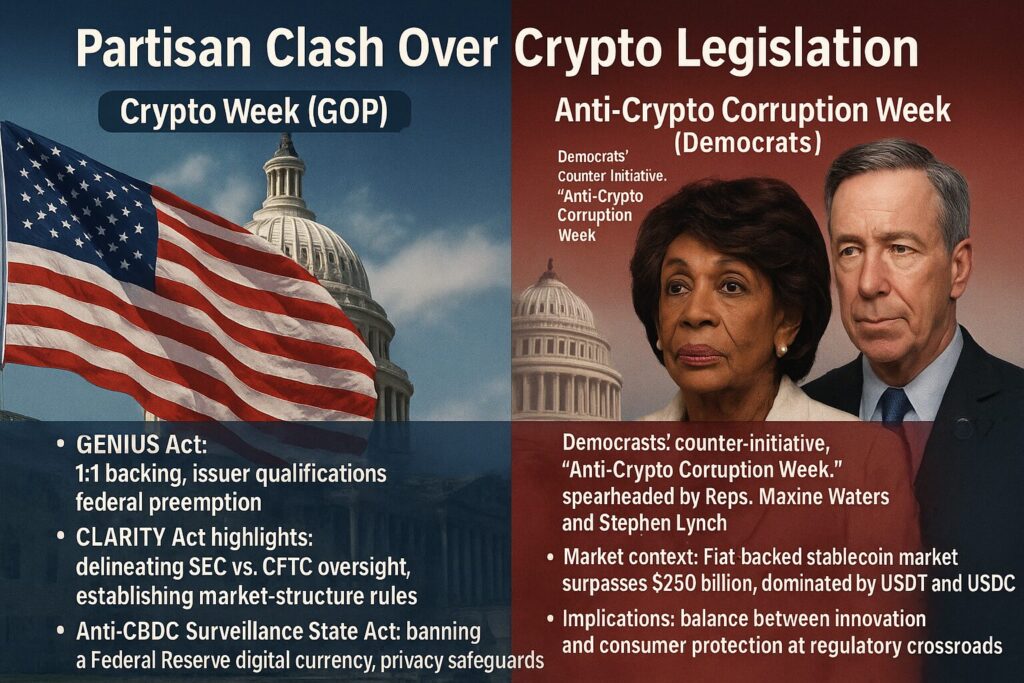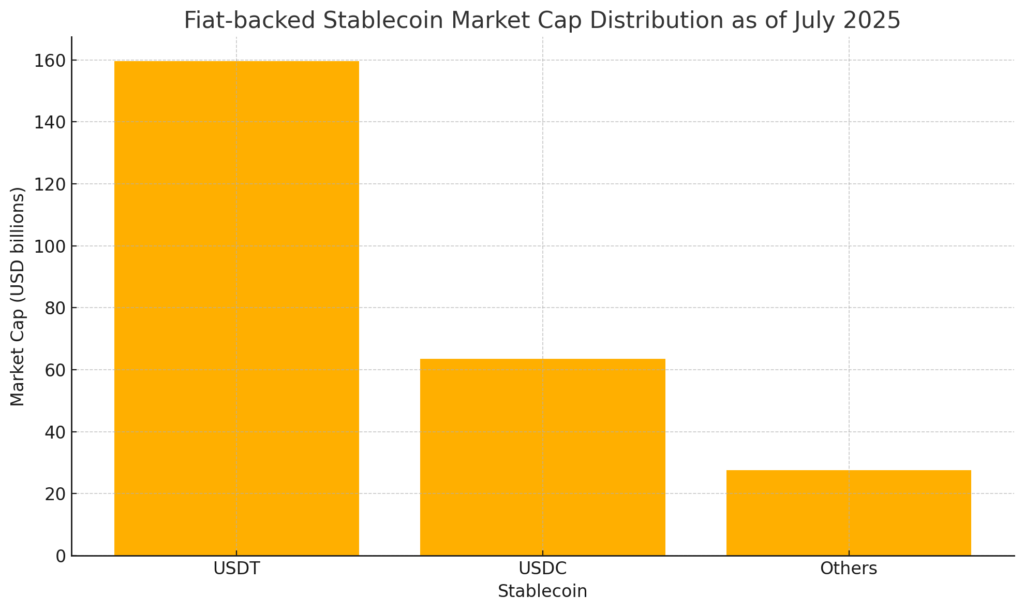
Main Points:
- House Republicans’ “Crypto Week” to advance three landmark bills: the GENIUS Act, the CLARITY Act, and the Anti-CBDC Surveillance State Act
- Democrats’ counter-initiative, “Anti-Crypto Corruption Week”, spearheaded by Reps. Maxine Waters and Stephen Lynch
- Key provisions of the GENIUS Act: 1:1 backing, issuer qualifications, federal preemption
- CLARITY Act highlights: delineating SEC vs. CFTC oversight, establishing market-structure rules
- Anti-CBDC Surveillance State Act: banning a Federal Reserve digital currency, privacy safeguards
- Market context: Fiat-backed stablecoin market surpasses $250 billion, dominated by USDT and USDC
- Implications: balance between innovation and consumer protection at a regulatory crossroads
The Stage is Set: House Republicans Declare “Crypto Week”
On July 13, 2025, Speaker Mike Johnson announced that the U.S. House of Representatives would dedicate the week of July 14th to “Crypto Week,” during which Republicans plan to bring three key crypto-related bills to the floor: the GENIUS Act, the CLARITY Act, and the Anti-CBDC Surveillance State Act. Majority Leader Steve Scalise emphasized that these measures align with President Trump’s agenda to establish the U.S. as the global leader in digital assets, offering clear regulatory frameworks to foster innovation.
Subtopics:
- Rationale behind concentrating legislation into one week
- Role of party unity and industry lobbying
Democratic Countermove: “Anti-Crypto Corruption Week”
In response, House Financial Services Committee Ranking Member Maxine Waters and Rep. Stephen Lynch announced an “Anti-Crypto Corruption Week” to block what they characterized as dangerous bills that risk empowering insider corruption and failing to protect consumers. Waters led Democrats through a 13-hour markup, proposing over 30 amendments to dilute stablecoin legislation that might benefit Trump-linked interests. Lynch warned that barring robust safeguards could hinder U.S. CBDC research, handing China a technological edge.
Subtopics:
- Key democratic objections
- Procedural tactics: block hearings, staged walkouts
The GENIUS Act: Charting a Federal Framework for Stablecoins
The GENIUS Act (Guiding and Establishing National Innovation for U.S. Stablecoins of 2025), passed by the Senate 68–30, aims to:
- Require 1:1 backing of stablecoins with cash or U.S. Treasuries
- Limit issuers to qualified banks and fintechs, with annual audits for those over $50 billion
- Preempt state laws to create a unified federal standard
Proponents argue this will open the door for retailers like Amazon and Walmart to issue their own tokens, potentially saving billions in transaction fees. Critics warn that without consumer-focused provisions, large incumbents could crowd out smaller innovators.
The CLARITY Act: Defining Roles of the SEC and CFTC
The CLARITY Act would:
- Establish clear definitions for digital assets
- Allocate oversight: SEC for token offerings, CFTC for exchange trading
- Mandate disclosures and registration for certain market participants
Backers believe this bill resolves long-standing jurisdictional ambiguity, while detractors, including the Americans for Financial Reform, argue it weakens enforcement and empowers “crypto grifters” by creating loopholes.
The Anti-CBDC Surveillance State Act: Blocking Fed-Backed Digital Currency
Originally introduced by Sen. Ted Cruz (R-TX) in June 2024, this legislation seeks to amend the Federal Reserve Act to:
- Prohibit the Fed from issuing a retail CBDC
- Prevent CBDC use for monetary policy tools like negative interest rates
- Protect individual privacy by banning direct Fed-to-person digital wallets
Supporters stress the need to guard against government surveillance, while opponents contend that a well-designed CBDC could enhance financial inclusion.
Market Dynamics: Stablecoin Market Size and Trends
As of July 2025, the total market capitalization of fiat-backed stablecoins stands at approximately $250.6 billion, with Tether’s USDT at $159.56 billion and Circle’s USDC at $63.47 billion. The remaining ~$27.58 billion is held by smaller issuers.
See the bar chart below for distribution:

(Chart displayed above)
This segment has witnessed steady growth, driven by DeFi applications, cross-border payments, and institutional adoption. Meanwhile, analysts predict that a clear federal framework could double the market by 2026, potentially reaching $500 billion if the GENIUS Act passes and spurs retail involvement.
Conclusion: A Regulatory Crossroads for Crypto Innovation
The duel between “Crypto Week” and “Anti-Crypto Corruption Week” encapsulates a broader debate: should regulation prioritize rapid innovation and market expansion, or should it err on the side of consumer protection and anti-corruption? As Congress weighs these pivotal bills, market participants must navigate uncertainty. Clear rules could unlock mainstream adoption and new use cases, but poorly crafted legislation risks stifling competition and reinforcing incumbent advantages. For crypto investors and practitioners seeking the next growth opportunities, the outcome of this regulatory skirmish will define the contours of U.S. digital finance for years to come.

